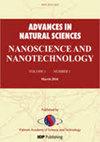ZnS脱壳提高AgInSe2纳米晶体的稳定性和发光效率
IF 2.1
Q3 MATERIALS SCIENCE, MULTIDISCIPLINARY
Advances in Natural Sciences: Nanoscience and Nanotechnology
Pub Date : 2023-06-01
DOI:10.1088/2043-6262/acd92a
引用次数: 0
摘要
本文在有机溶剂中采用一锅法合成了AgInSe2 (AISe)核和AgInSe2/ZnS (AISe/ZnS)核/壳纳米晶体。首先,在100℃~ 180℃的不同温度下,将Se前驱体热注入Ag和In配合物中,反应时间为20 min,合成了不同尺寸的AIS核纳米结构。然后,在150℃的温度下,将ZnS生长在AIS核纳米结构表面60 min,得到了AIS /ZnS核/壳结构。采用x射线衍射(XRD)、扫描电子显微镜(SEM)、x射线光电子能谱(XPS)和光谱学(紫外-可见吸收和光致发光(PL))对合成的AISe核和AISe/ZnS核/壳纳米管进行了表征。在脱壳ZnS层后,通过改变反应温度(100℃~ 180℃),在610 ~ 762 nm范围内,AISe/ZnS核/壳纳米材料在空气中变得更加稳定(12个月),并发出强发光,量子产率(QY)高达40%。通过合金结构的形成和表面态的钝化,可以解释在表面上涂覆ZnS后所观察到的QY增加和光致发光光谱蓝移现象。由于其优异的发光性能,AISe核和AISe/ZnS核/壳纳米管在设计温室、室内农业和生物相关设备的固态照明光源方面非常有前途。本文章由计算机程序翻译,如有差异,请以英文原文为准。
Improved stability and luminescent efficiency of AgInSe2 nanocrystals by shelling with ZnS
In this paper, AgInSe2 (AISe) core and AgInSe2/ZnS (AISe/ZnS) core/shell nanocrystals (NCs) were synthesised by a one-pot method in an organic solvent. Firstly, the synthesis of AIS core NCs with different sizes was performed by hot-injection of Se precursor into the Ag and In complexes at different temperatures from 100 °C to 180 °C for a reaction time of 20 min Then, the ZnS was grown on the surface of AISe NCs at 150 °C for 60 min to produce the AISe/ZnS core/shell structures. The as-synthesised AISe core and AISe/ZnS core/shell NCs were characterised by using x-ray diffraction (XRD), scanning electron microscopy (SEM), X-ray photoelectron spectroscopy (XPS) and optical spectroscopies (UV–vis absorption and photoluminescence (PL)). After shelling ZnS layer, AISe/ZnS core/shell NCs become more stable (12 months) in ambient air and emit strong luminescence with a high quantum yield (QY) of 40% in the range from 610 nm to 762 nm by varying the reaction temperature of AISe core synthesis from 100 °C to 180 °C. The observed increase of QY and blue-shift in photoluminescence spectra after coating ZnS on surface AISe core NCs are rationalised by the formation of the alloyed structure and passivation of surface states. With their outstanding luminescent properties, AISe core and AISe/ZnS core/shell NCs are very promising in designing emitters for solid-state lighting sources in the greenhouse and in-door farming and bio-related devices.
求助全文
通过发布文献求助,成功后即可免费获取论文全文。
去求助
来源期刊

Advances in Natural Sciences: Nanoscience and Nanotechnology
NANOSCIENCE & NANOTECHNOLOGYMATERIALS SCIE-MATERIALS SCIENCE, MULTIDISCIPLINARY
自引率
4.80%
发文量
0
 求助内容:
求助内容: 应助结果提醒方式:
应助结果提醒方式:


